Laboratory and Medical Scale Ozone Generator Market Size and Share Forecast Outlook 2025 to 2035
The laboratory and medical scale ozone generator market is expected to grow from USD 57.8 million in 2025 to USD 136.8 million in 2035, reflecting a CAGR of 9.0%. This growth represents an absolute dollar opportunity of USD 79.0 million over the forecast period. Early growth sees the market rise from USD 63.0 million in 2026 to USD 74.8 million in 2029, indicating steady incremental gains.
By 2031, the market will reach USD 88.9 million, highlighting mid-term growth momentum. These increases provide manufacturers and distributors opportunities to scale production, optimize supply chains, and capture consistent revenue across growing applications. In the later phase, the market delivers the largest absolute gains, rising from USD 105.6 million in 2032 to USD 136.8 million in 2035. This late-stage expansion contributes USD 31.2 million in incremental revenue, with annual gains accelerating toward the end of the forecast period. Intermediate years, such as USD 115.1 million in 2033 and USD 125.5 million in 2034, act as bridging periods that sustain momentum. Overall, the cumulative USD 79.0 million opportunity highlights significant long-term revenue potential, enabling stakeholders to align production and distribution strategies with growth milestones in the laboratory and medical scale ozone generator market.
Quick Stats for Laboratory and Medical Scale Ozone Generator Market
Laboratory and Medical Scale Ozone Generator Market Value (2025): USD 57.8 million
Laboratory and Medical Scale Ozone Generator Market Forecast Value (2035): USD 136.8 million
Laboratory and Medical Scale Ozone Generator Market Forecast CAGR: 9.0%
Leading Segment in Laboratory and Medical Scale Ozone Generator Market in 2025: Corona Discharge (46.8%)
Key Growth Regions in Laboratory and Medical Scale Ozone Generator Market: North America, Asia-Pacific, Europe
Top Key Players in Laboratory and Medical Scale Ozone Generator Market: Aurozone, A2Z Ozone, Eltech Ozone, Hansler Medical, Jelight Company, Medozons, Ozone Solutions, VWR, Veolia Water Technologies & Solutions, Xylem Water Solutions
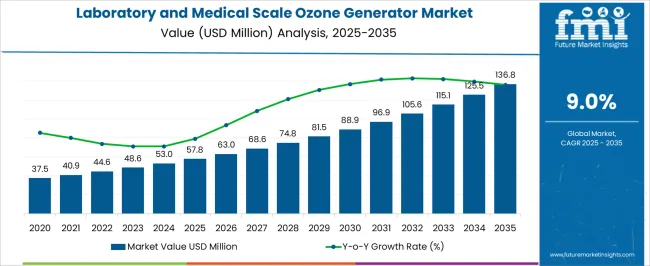
Laboratory and Medical Scale Ozone Generator Market Key Takeaways
Metric
Value
Laboratory and Medical Scale Ozone Generator Market Estimated Value in (2025 E)
USD 57.8 million
Laboratory and Medical Scale Ozone Generator Market Forecast Value in (2035 F)
USD 136.8 million
Forecast CAGR (2025 to 2035)
9.0%
In the laboratory and medical scale ozone generator market, the first breakpoint occurs between 2025 and 2027, when the market grows from USD 57.8 million to USD 63.0 million. This early phase reflects steady adoption with moderate annual increments of around USD 2–3 million, establishing a foundation for predictable growth. The next significant breakpoint is observed between 2029 and 2031, as the market advances from USD 74.8 million to USD 88.9 million.
During this stage, absolute dollar gains accelerate, indicating mid-term growth momentum. Manufacturers and distributors can leverage this period to optimize production, strengthen supply chains, and capture incremental revenue effectively. The final major breakpoint emerges between 2032 and 2035, when the market surges from USD 105.6 million to USD 136.8 million, representing the largest absolute dollar increase in the forecast period. Intermediate years, such as USD 115.1 million in 2033 and USD 125.5 million in 2034, serve as bridging periods sustaining momentum before peak values are reached. Recognizing these breakpoints allows stakeholders to strategically plan capacity expansion, operational efficiencies, and investment timing.
Why is the Laboratory and Medical Scale Ozone Generator Market Growing?
The laboratory & medical scale ozone generator market is experiencing steady growth driven by increasing adoption in sterilization, water treatment, and medical disinfection applications. The current market scenario reflects heightened demand for ozone-based solutions due to their effectiveness in eliminating pathogens without harmful chemical residues. Growing awareness regarding the benefits of ozone in medical environments and industrial processes is accelerating market expansion.
Advances in ozone generator technology have improved efficiency, reliability, and safety, which in turn support broader acceptance. Regulatory focus on sterilization standards and environmentally friendly treatment methods is further influencing growth opportunities.
The market outlook remains positive as ongoing investments in healthcare infrastructure and industrial water treatment systems drive continued demand. Increasing use of ozone generators in emerging economies, coupled with innovation in compact, scalable units for laboratory and medical settings, is anticipated to sustain market momentum in the coming years.
Segmental Analysis
The laboratory and medical scale ozone generator market is segmented by technology, end use, and geographic regions. By technology, laboratory and medical scale ozone generator market is divided into Corona Discharge, Ultraviolet, Cold Plasma, and Electrolytic.
In terms of end use, laboratory and medical scale ozone generator market is classified into Industrial, Commercial, and Municipal. Regionally, the laboratory and medical scale ozone generator industry is classified into North America, Latin America, Western Europe, Eastern Europe, Balkan & Baltic Countries, Russia & Belarus, Central Asia, East Asia, South Asia & Pacific, and the Middle East & Africa.
Insights into the Corona Discharge Technology Segment
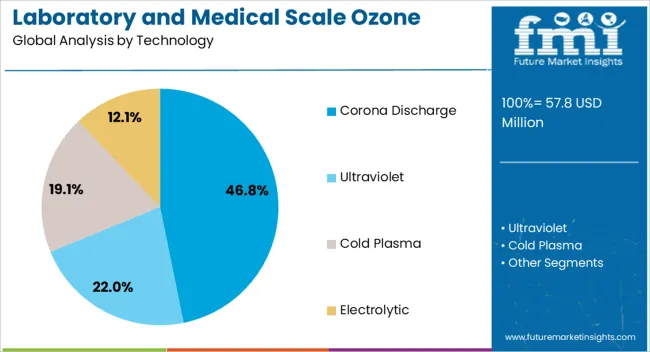
The Corona Discharge technology segment is projected to hold 46.8% of the overall Laboratory & Medical Scale Ozone Generator market revenue share in 2025, positioning it as the leading technology type. This prominence is attributed to the technology’s ability to generate high concentrations of ozone efficiently and consistently, which is essential for both medical sterilization and industrial applications.
The durability and scalability of corona discharge units allow for flexible deployment across various operational scales. Additionally, this technology’s compatibility with continuous operation and lower maintenance requirements has driven its widespread adoption.
The segment’s growth is further supported by improvements in electrical components and system designs that enhance energy efficiency and ozone output control, aligning with stringent safety and environmental regulations.
Insights into the Industrial End Use Segment
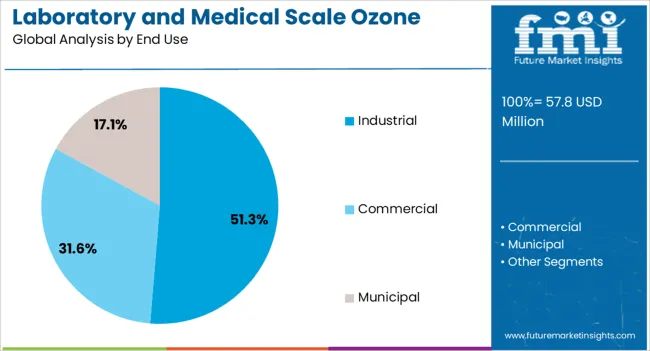
The Industrial end use segment is expected to account for 51.3% of the Laboratory & Medical Scale Ozone Generator market revenue share in 2025, making it the dominant end-use category. This leadership is driven by the expanding use of ozone generators in industrial water treatment, food processing, and wastewater management, where ozone’s strong oxidative properties enable effective purification and disinfection.
The segment benefits from rising industrial standards for hygiene and environmental compliance, which promote the adoption of ozone as a green alternative to chemical disinfectants. Additionally, the demand for sustainable and cost-effective sterilization methods in manufacturing processes has fueled growth.
The ability of ozone generators to reduce water and energy consumption in industrial settings further supports the segment’s expansion. As industries continue to prioritize eco-friendly and efficient treatment solutions, the industrial end-use segment is expected to maintain its market dominance.
What are the Drivers, Restraints, and Key Trends of the Laboratory and Medical Scale Ozone Generator Market?
The laboratory and medical scale ozone generator market is expanding due to rising demand in water purification, sterilization, and laboratory research applications. North America and Europe lead with advanced, safety-compliant ozone generators for hospitals, research institutions, and diagnostic labs. Asia-Pacific is witnessing rapid growth driven by healthcare infrastructure expansion and increasing laboratory research activities. Manufacturers differentiate through ozone output capacity, precision control, material durability, and safety features. Regional differences in regulatory standards, adoption rates, and technological infrastructure influence procurement, usage, and competitive positioning globally.
Ozone Output Capacity and Precision Control Influence Adoption
Ozone generators are selected based on output capacity, concentration stability, and precision control for laboratory and medical applications. North America and Europe emphasize generators capable of precise ozone dosing for sterilization, water treatment, and analytical procedures, ensuring compliance with strict safety and operational standards. Asia-Pacific markets prioritize small to mid-capacity generators for healthcare facilities and research labs, balancing cost and operational needs. Differences in output capacity and control precision affect application suitability, reliability, and process efficiency. Manufacturers offering highly accurate, stable, and adjustable generators capture premium adoption, while regional producers focus on cost-effective, functional units. Output and control contrasts shape adoption patterns, operational performance, and competitiveness across healthcare and laboratory sectors globally.
Safety Standards and Regulatory Compliance Drive Market Growth
Compliance with safety regulations, electrical standards, and medical device certifications is critical for adoption. North America and Europe enforce stringent standards for ozone exposure limits, material safety, and operational reliability, particularly for medical and laboratory use. Asia-Pacific markets vary, with high-budget facilities adhering to similar standards while smaller labs adopt generators meeting local safety requirements. Differences in regulatory compliance affect product design, certification processes, and market acceptance. Suppliers providing certified, safety-compliant ozone generators gain access to high-value healthcare and research markets, while regional manufacturers focus on affordable, locally compliant solutions. Regulatory contrasts determine adoption speed, procurement confidence, and long-term market positioning globally.
Material Durability and Maintenance Requirements Affect Reliability
Durability of components, including ozone-resistant materials for electrodes, tubing, and chambers, is crucial for consistent generator performance. North America and Europe demand long-lasting, corrosion-resistant materials suitable for frequent medical and laboratory applications to minimize downtime and maintenance. Asia-Pacific markets often prioritize cost-effective designs using standard materials for moderate-use applications, balancing affordability and operational reliability. Differences in material durability and maintenance cycles impact total cost of ownership, service frequency, and generator lifespan. Manufacturers offering durable, low-maintenance ozone generators gain trust and premium adoption, while regional suppliers provide reliable, functional units at competitive prices. Durability contrasts strongly influence adoption, operational reliability, and long-term competitiveness in laboratory and medical markets.
Distribution Networks and Technical Support Determine Market Reach
Distribution channels, installation support, and after-sales services significantly affect generator adoption. North America and Europe rely on OEM partnerships, professional distributors, and structured service agreements to ensure proper installation, calibration, and maintenance. Asia-Pacific depends on local dealers, regional distributors, and online channels for accessibility, especially for small laboratories and clinics. Differences in distribution and support infrastructure influence user confidence, operational reliability, and repeat purchases. Suppliers offering comprehensive service networks, training, and remote monitoring gain competitive advantage, while regional producers focus on accessibility and cost-efficient support. Distribution contrasts shape adoption, service quality perception, and market penetration across healthcare, research, and laboratory segments globally.
Analysis of Laboratory and Medical Scale Ozone Generator Market By Key Countries
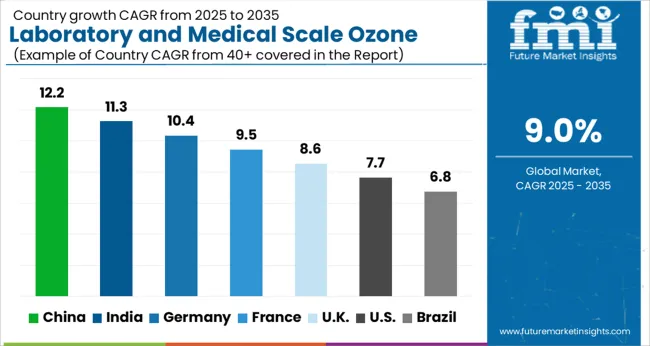
Country
CAGR
China
12.2%
India
11.3%
Germany
10.4%
France
9.5%
UK
8.6%
USA
7.7%
Brazil
6.8%
The global laboratory and medical scale ozone generator market was projected to grow at a 9.0% CAGR through 2035, driven by demand in medical, laboratory, and sterilization applications. Among BRICS nations, China recorded 12.2% growth as large-scale manufacturing and deployment facilities were commissioned and compliance with medical and industrial safety standards was enforced, while India at 11.3% growth saw expansion of production units to meet rising regional demand. In the OECD region, Germany at 10.4% maintained substantial output under strict industrial and regulatory frameworks, while the United Kingdom at 8.6% relied on moderate-scale operations for laboratory and medical applications. The USA, expanding at 7.7%, remained a mature market with steady demand across healthcare, laboratory, and sterilization segments, supported by adherence to federal and state-level quality and safety standards. This report includes insights on 40+ countries; the top markets are shown here for reference.
Laboratory and Medical Scale Ozone Generator Market Growth in India
India is witnessing growth at a CAGR of 11.3% in the laboratory and medical scale ozone generator market due to rising adoption in healthcare, research, water treatment, and pharmaceutical sectors. Hospitals and laboratories are implementing ozone generators for sterilization, air purification, and water treatment applications. Growth is supported by increasing healthcare infrastructure, expansion of diagnostic and research laboratories, and awareness of advanced sterilization technologies. Suppliers provide compact, efficient, and safe ozone generators suitable for laboratory and medical applications. Distribution through medical equipment dealers, laboratory suppliers, and online channels ensures wide accessibility. Adoption is further driven by operational efficiency, safety compliance, and growing emphasis on infection control. India continues to see strong market momentum due to expanding healthcare services, rising laboratory activities, and demand for advanced sterilization solutions.
Hospitals and laboratories increased adoption
Suppliers offered compact and efficient ozone generators
Healthcare infrastructure and research expansion supported growth
Laboratory and Medical Scale Ozone Generator Market Trends in Germany
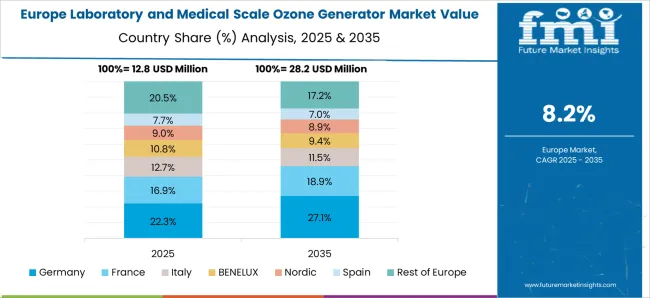
Germany is growing at a CAGR of 10.4% in the laboratory and medical scale ozone generator market due to rising demand from hospitals, clinical laboratories, and water treatment facilities. Organizations adopt ozone generators for sterilization of medical instruments, air purification, and water treatment applications. Growth is supported by strict hygiene standards, healthcare infrastructure development, and increasing adoption of advanced sterilization technologies. Suppliers offer generators with precise ozone output, user friendly designs, and safety features suitable for laboratory and medical environments. Distribution channels include medical equipment suppliers, laboratory distributors, and direct sales networks, ensuring wide accessibility. Adoption is further driven by operational efficiency, compliance with healthcare regulations, and demand for reliable sterilization solutions. Germany remains a key European market due to strong healthcare infrastructure and rising research and medical facility investments.
Hospitals and clinical laboratories drove adoption
Suppliers provided precise and user friendly ozone generators
Healthcare standards and research investments supported growth
Laboratory and Medical Scale Ozone Generator Market Overview in China
The laboratory and medical scale ozone generator market in China is growing at a CAGR of 12.2% driven by increasing adoption in hospitals, research laboratories, water treatment facilities, and pharmaceutical applications. Organizations are using ozone generators for sterilization, disinfection, and purification of air, water, and medical instruments. Growth is supported by rising healthcare infrastructure investments, expansion of research and clinical laboratories, and growing demand for advanced sterilization methods. Suppliers offer generators with precise ozone output, compact design, and safety features suitable for laboratory and medical environments. Distribution through medical equipment dealers, laboratory suppliers, and direct sales ensures broad accessibility. Adoption is further supported by the need for reliable sterilization solutions, operational efficiency, and compliance with health and safety standards. China remains a leading market due to increasing healthcare facilities, laboratory expansion, and focus on advanced medical equipment.
Hospitals and research laboratories drove adoption
Suppliers provided precise and safe ozone generators
Healthcare expansion and sterilization needs supported growth
Laboratory and Medical Scale Ozone Generator Market Development in the United Kingdom
The United Kingdom market is expanding at a CAGR of 8.6% due to increasing adoption in hospitals, research laboratories, water treatment facilities, and pharmaceutical sectors. Organizations are using ozone generators for sterilization, air and water purification, and medical equipment disinfection. Growth is supported by rising healthcare infrastructure, laboratory expansion, and awareness of advanced sterilization methods. Suppliers provide compact, efficient, and safe ozone generators suitable for laboratory and medical applications. Distribution through medical equipment dealers, laboratory suppliers, and online channels ensures broad accessibility. Adoption is further driven by operational efficiency, safety compliance, and increasing focus on infection prevention. The United Kingdom continues to see steady growth due to expanding healthcare services, laboratory activity, and demand for reliable sterilization solutions.
Hospitals and laboratories increased adoption
Suppliers offered efficient and safe ozone generators
Healthcare expansion and infection control needs supported growth
Laboratory and Medical Scale Ozone Generator Market Insights in the United States
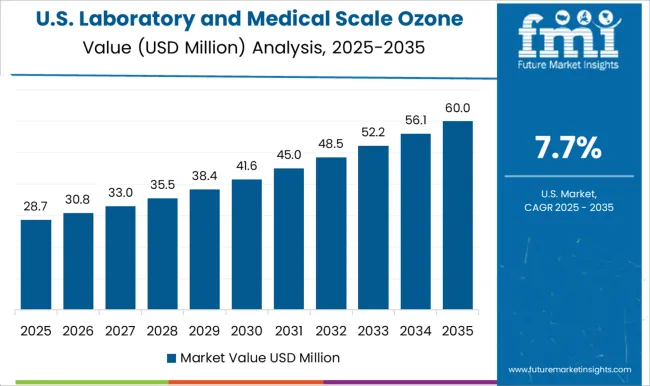
The United States market is growing at a CAGR of 7.7% supported by rising adoption in hospitals, research laboratories, water treatment plants, and pharmaceutical sectors. Ozone generators are used for sterilization, air purification, and water treatment to ensure hygiene and safety in medical and laboratory environments. Growth is supported by expanding healthcare infrastructure, research facilities, and emphasis on advanced sterilization technologies. Suppliers provide ozone generators with precise output, compact design, and safety compliance suitable for laboratory and medical applications. Distribution channels include medical equipment dealers, laboratory suppliers, and online platforms ensuring broad market access. Adoption is further driven by operational efficiency, regulatory compliance, and growing infection control requirements. The United States remains a key market due to its advanced healthcare infrastructure and high demand for reliable sterilization solutions.
Hospitals and research laboratories drove adoption
Suppliers provided precise and compliant ozone generators
Healthcare infrastructure and infection control needs supported growth
Competitive Landscape of Laboratory and Medical Scale Ozone Generator Market
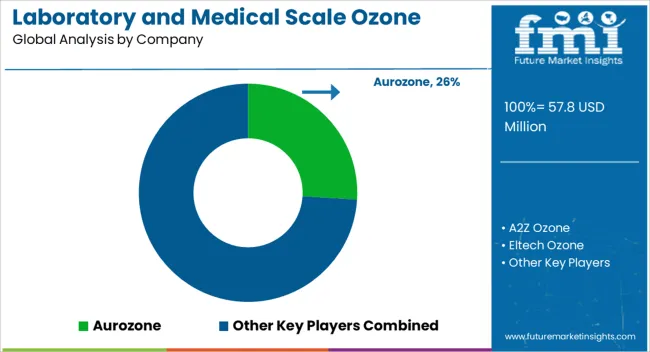
The laboratory and medical scale ozone generator market is served by key players such as Aurozone, A2Z Ozone, Eltech Ozone, Hansler Medical, Jelight Company, Medozons, Ozone Solutions, VWR, Veolia Water Technologies & Solutions, and Xylem Water Solutions. These companies specialize in designing and manufacturing ozone generators that deliver precise ozone concentrations for medical sterilization, laboratory experiments, water treatment, and disinfection processes. Products range from compact bench-top units to modular systems suitable for small-scale medical and research applications, emphasizing reliability, safety, and ease of operation. Companies like Aurozone, Jelight Company, and Ozone Solutions focus on producing laboratory-grade ozone generators with advanced controls for accurate ozone dosing and monitoring.
Hansler Medical and Medozons cater specifically to medical applications, providing devices for the sterilization of instruments, surgical environments, and therapeutic ozone treatments. Meanwhile, Veolia Water Technologies, VWR, and Xylem offer integrated solutions for ozone-based water purification, emphasizing compliance with regulatory standards and consistent performance for critical applications. The market is witnessing growing demand for ozone generators that combine efficiency with compact design, low maintenance, and energy-saving operation. Innovations include automated control systems, remote monitoring, and modular scalability to accommodate diverse laboratory and medical needs.
Key Players in the Laboratory and Medical Scale Ozone Generator Market
Aurozone
A2Z Ozone
Eltech Ozone
Hansler Medical
Jelight Company
Medozons
Ozone Solutions
VWR
Veolia Water Technologies & Solutions
Xylem Water Solutions
Scope of the Report
Item
Value
Quantitative Units
USD 57.8 Million
Technology
Corona Discharge, Ultraviolet, Cold Plasma, and Electrolytic
End Use
Industrial, Commercial, and Municipal
Regions Covered
North America, Europe, Asia-Pacific, Latin America, Middle East & Africa
Country Covered
United States, Canada, Germany, France, United Kingdom, China, Japan, India, Brazil, South Africa
Key Companies Profiled
Aurozone, A2Z Ozone, Eltech Ozone, Hansler Medical, Jelight Company, Medozons, Ozone Solutions, VWR, Veolia Water Technologies & Solutions, and Xylem Water Solutions
Additional Attributes
Dollar sales vary by generator type, including corona discharge, UV, and electrolytic ozone generators; by application, such as sterilization, water treatment, air purification, and laboratory research; by end-use industry, spanning hospitals, research labs, and pharmaceutical facilities; by region, led by North America, Europe, and Asia-Pacific. Growth is driven by rising demand for disinfection, laboratory testing, and medical sterilization solutions.

